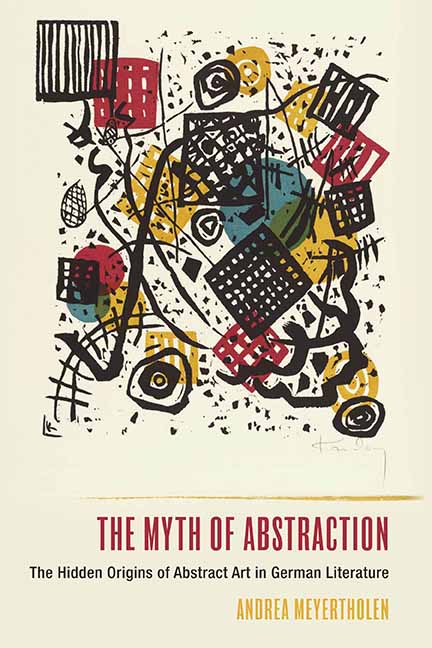Book contents
- Frontmatter
- Dedication
- Contents
- List of Illustrations
- Acknowledgments
- Introduction: The Many Origins of Abstract Art
- 1 Apocalypse Now: Heinrich Von Kleist’s Sublime Deframing of Caspar David Friedrich’s Der Mönch Am Meer (1810)
- 2 The Kleistian Sublime Is Now: Kazimir Malevich, Mark Rothko, Barnett Newman
- 3 The Clouding of Perception: Seeing The (Un)Real Potential for Abstraction in the Poetry and Science of Goethe’s Clouds (1821)
- 4 In the Service of Clouds or Optical Illusion?: Romanticism, Pointillism, and Impressionism
- 5 Driven to Distraction and from Abstraction: The Birth and Death of Abstract Art in Gottfried Keller’s Der Grüne Heinrich (1854/55, 1879/80)
- 6 Inside the Mind and Outside the Margins: The Unruly Lines of Paul Klee, André Masson, and Cy Twombly
- Epilogue: Laocoön and His Sisters: The Future of Literature and Art
- Bibliography
- Index
2 - The Kleistian Sublime Is Now: Kazimir Malevich, Mark Rothko, Barnett Newman
Published online by Cambridge University Press: 07 May 2022
- Frontmatter
- Dedication
- Contents
- List of Illustrations
- Acknowledgments
- Introduction: The Many Origins of Abstract Art
- 1 Apocalypse Now: Heinrich Von Kleist’s Sublime Deframing of Caspar David Friedrich’s Der Mönch Am Meer (1810)
- 2 The Kleistian Sublime Is Now: Kazimir Malevich, Mark Rothko, Barnett Newman
- 3 The Clouding of Perception: Seeing The (Un)Real Potential for Abstraction in the Poetry and Science of Goethe’s Clouds (1821)
- 4 In the Service of Clouds or Optical Illusion?: Romanticism, Pointillism, and Impressionism
- 5 Driven to Distraction and from Abstraction: The Birth and Death of Abstract Art in Gottfried Keller’s Der Grüne Heinrich (1854/55, 1879/80)
- 6 Inside the Mind and Outside the Margins: The Unruly Lines of Paul Klee, André Masson, and Cy Twombly
- Epilogue: Laocoön and His Sisters: The Future of Literature and Art
- Bibliography
- Index
Summary
WHEN WAS THE WORLD READY, so to speak, for the apocalypse? The twentieth century witnessed numerous and diverse forms of abstract art, but the most provocative manifestations of the particular moment of abstraction envisioned by Kleist, both visually and philosophically, are the Suprematist shapes of Russian-born Kazimir Malevich (1878–1935) and the monumental color field paintings of post-World War II America, particularly the works of Mark Rothko (1903–70) and Barnett Newman (1905–70). Their fields of overwhelming size and overpowering color envelop the spectator in an unframed realm of metaphysical space and immediate sensation whose presence defies distance or restriction. The visual and formal affinities between works like Der Mönch am Meer and Rothko's Green on Blue (1956) were noted already in 1961 by American art historian Robert Rosenblum (1927–2006), who developed the term “abstract sublime” to establish a common spiritual heritage linking nineteenth- century Romantic landscape painting with the abstract expressionism of mid-century modern America. Rosenblum's controversial thesis has been largely dismissed as, to quote former New York Times art critic Hilton Kramer, “the sheerest hokum—brilliant hokum, amusing hokum, but hokum all the same” owing to insufficient factual grounding and an overreliance on loose formal correspondences like size and shape. While Rothko's and Newman's seas of abstract color and even Malevich's smaller monochrome fields contain vestiges of Friedrich's abstracted seascape, these twentieth-century creations more closely answer Kleist's prophetic nineteenth-century call for an apocalyptically abstract art that brings forth sublime sensations that are able to pull the earth out from under the spectator's feet and blow the eyelids off any viewer.
To Infinity and Beyond: Malevich's Suprematist Geometry
Kazimir Malevich's Black Square from 1913 (fig. 2.1) is not what it seems. Contrary to its appearance, the image is neither a square nor truly black; nor, indeed, is Black Square even its true title. The color perceived as “black” is really a mixture of variegated pigments—not a single one of them being black. The shape perceived as “square” is really what the artist called a “painterly mass” of thick oil and enamel paints applied by hand with such uneven distribution and mathematical imprecision that its sides do not parallel the edges of the canvas.
- Type
- Chapter
- Information
- The Myth of AbstractionThe Hidden Origins of Abstract Art in German Literature, pp. 55 - 98Publisher: Boydell & BrewerPrint publication year: 2021



